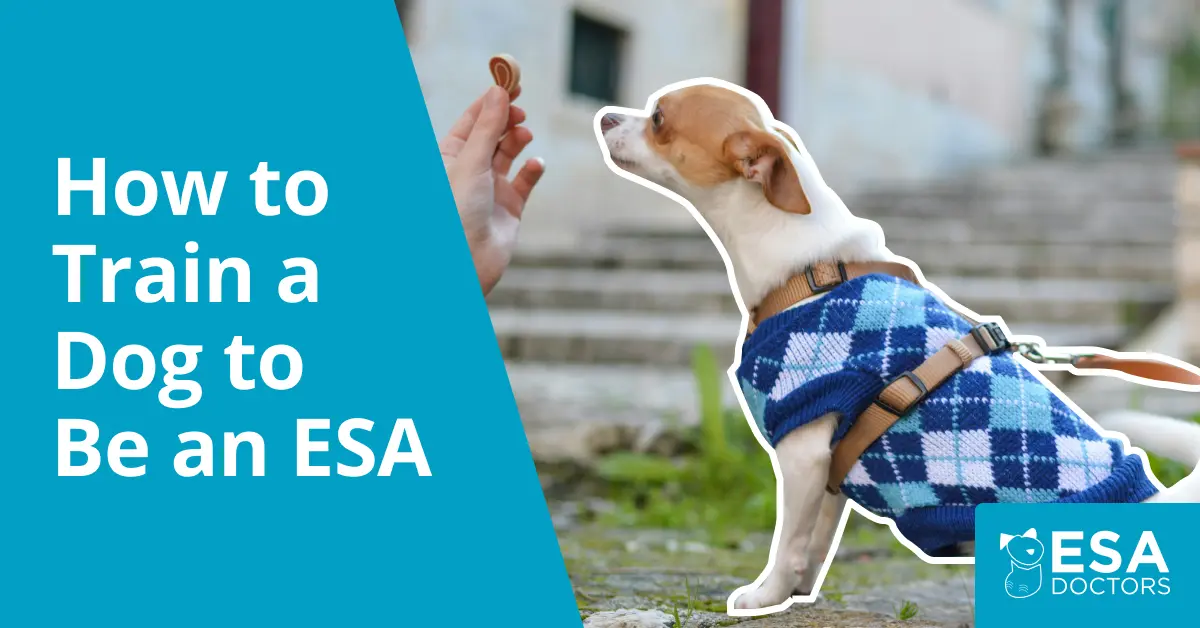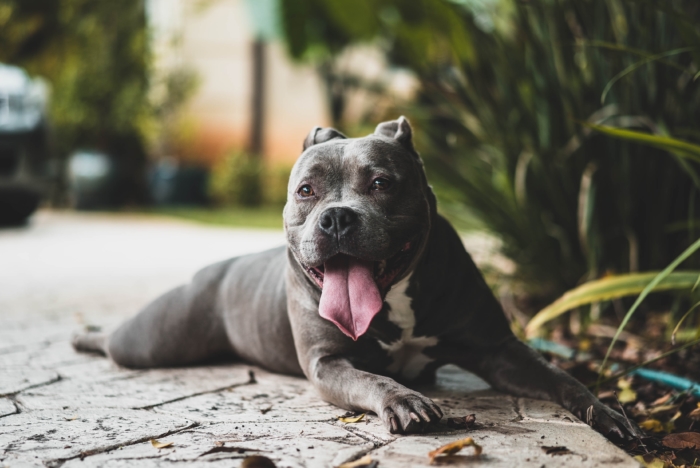First and foremost, specialized training is not legally required for emotional support animals (ESAs), which makes them different from psychiatric service dogs. However, they should still have basic obedience training mastered. There are also ways to train a dog to become a more effective emotional support dog, even if it’s not required.
In this article, we will explain the training requirements for emotional support dogs and share tips and advice for properly training them.
- What training requirements are there for emotional support animals?
- What trained qualities should an emotional support dog possess?
- Tips on Training Your Emotional Support Dog
- A Quick Trick to Teach Your Dog to Calm Your Anxiety
- Emotional Support Dogs Help
See if you qualify for an ESA letter today!
What training requirements are there for emotional support animals?
Under federal guidelines, emotional support dogs do NOT need any specialized training. Emotional support dogs provide comfort to their owner in times of distress by being loyal and present companions. But note, to maintain housing rights, an emotional support dog does need general training to be well-behaved and safe for other residents.
If an emotional support dog frequently disrupts the neighbors, goes to the bathroom where it isn’t supposed to, damages property, or attacks someone, these can be reasons for disallowing the dog, even with ESA status. Like other animals and humans living in residential buildings, ESAs are expected to be good neighbors.
What trained qualities should an emotional support dog possess?
ESA owners should strive to train their emotional support dogs to have the following qualities:
1. Basic Obedience
Training Goal: Teach your ESA to respond to their name and follow basic commands like “sit,” “stay,” and “come.”
Why It’s Important: Basic obedience ensures your ESA is manageable and safe in various situations. It helps prevent accidents and makes your animal a more welcome presence in different environments.
2. Calm Behavior in Public
Training Goal: Train your ESA to remain quiet, avoid jumping on people, and stay calm in new environments.
Why It’s Important: Calm public behavior is crucial for maintaining housing rights and access to common areas. Disruptive behavior can lead to complaints and potentially jeopardize your ability to keep your ESA in rental housing.
3. Proper Potty Habits
Training Goal: Ensure your ESA uses designated areas for bathroom needs and can signal when they need to go.
Why It’s Important: Proper bathroom habits are essential for maintaining a clean living environment and preventing property damage. Inappropriate elimination can lead to conflicts with landlords or property managers, potentially risking your housing situation.
4. Socialization
Training Goal: Teach your ESA to be comfortable around different people and animals without showing aggression or fear.
Why It’s Important: Good socialization helps prevent conflicts with neighbors, other pets, or strangers. It ensures your ESA can accompany you in common areas without causing stress or issues.
5. Emotional Responsiveness
Training Goal: Develop your ESA’s ability to recognize your distress and provide comfort when needed.
Why It’s Important: This is optional but can help your ESA provide better support. An emotionally responsive dog can provide better support during times of stress or anxiety, fulfilling their primary role more effectively.
6. Household Manners
Training Goal: Train your ESA to respect household boundaries and avoid destructive behaviors.
Why It’s Important: Good household manners prevent property damage and create a more harmonious living environment. This is especially important in rental situations where property damage could lead to financial penalties or eviction.
7. Noise Control
Training Goal: Train your ESA to minimize excessive vocalization and respond to “quiet” commands.
Why It’s Important: Excessive noise can be disruptive to neighbors and may violate noise ordinances or lease agreements. Controlling your ESA’s vocalizations helps maintain positive relationships with neighbors and landlords.
Tips on Training Your Emotional Support Dog

Training an emotional support dog is a rewarding journey that can help your furry friend become a calm, well-behaved companion. Here are some general tips and practical advice to help you train your emotional support dog.
1. Start with Basic Obedience Training
Basic obedience is the foundation of any good training program. Start with simple commands like “sit,” “stay,” and “come.” Here’s how to teach some of these basic commands:
- “Sit”: Hold a treat close to your dog’s nose, then slowly move it over their head. As their head follows the treat, their bottom should naturally lower to the ground. When they sit, say “sit,” and reward them with the treat and praise. Repeat this exercise for about 5-10 minutes each day.
- “Stay”: Ask your dog to sit, then hold your hand out, palm facing them, and say “stay.” Take one step back. If your dog stays in place, give them a treat and praise them. Gradually increase the distance and time they need to stay before rewarding them.
- “Come”: Attach a leash to your dog’s collar and say “come” in a cheerful voice while gently pulling the leash towards you. When your dog comes to you, reward them with treats and praise. Practice this in different places with different distractions to make sure your dog learns to come when called, no matter where you are.
2. Socialize Your Dog with New People and Places
Socialization helps your dog become comfortable around new people, animals, and environments. Here’s how to do it:
- New Environments: Start by taking your dog to quiet places like a park or an open field. If they remain calm, reward them with treats and praise. As they get used to these environments, gradually introduce them to busier places like streets or shopping areas. Always reward them for calm behavior.
- Meeting New People and Dogs: Arrange for your dog to meet different types of people—men, women, children, and even people in uniforms. Allow your dog to approach new people slowly, and reward them when they remain calm and friendly. When meeting other dogs, start with calm, friendly dogs in a neutral space, and keep an eye on body language to ensure positive interactions.
3. Teach Your Dog to Relax
Helping your dog learn to stay calm is important, especially when they might feel stressed or anxious. Try these techniques:
- “Settle” Command: Pick a spot in your home, like a mat or bed, and train your dog to lie down there. Say “settle” and encourage them to lie down. When they do, give them a treat and praise. Gradually increase the time they stay in this spot, rewarding them for calm behavior.
- Practice Calm Behavior: During normal daily activities, like after a walk or playtime, practice calm behaviors by using a calm voice, slow movements, and gentle petting to help them relax.
4. Help Your Dog Overcome Fears
Some dogs may be scared of certain things, like loud noises or new places. You can help them feel more comfortable using desensitization and counterconditioning:
- Get Used to Loud Noises: Play recordings of sounds like thunderstorms or fireworks at a low volume while giving your dog treats. Gradually increase the volume over time, always rewarding calm behavior.
- Create Positive Associations: If your dog is afraid of something specific, like a vacuum cleaner, use treats to create a positive association. Start with the vacuum off, rewarding your dog for calm behavior, and then gradually work up to having it on and moving.
5. Keep a Consistent Training Routine
Consistency is key in dog training. Here’s a sample daily training schedule:
- Morning: Spend 10 minutes practicing basic commands like “sit” and “stay,” followed by a 20 to 30-minute walk or play session.
- Afternoon: Practice socialization by visiting a new location or meeting new people or dogs, followed by a few minutes of relaxation training on a mat.
- Evening: Work on specific emotional support tasks, such as deep pressure therapy or behavior interruption, and finish with a fun play session or mental stimulation activity like a puzzle toy.
6. Adjust and Monitor Progress
Training is a gradual process, and every dog learns at their own pace. Keep a training journal to track your dog’s progress and make changes to your approach as needed. If you find certain challenges are too difficult, consider seeking help from a professional dog trainer or behaviorist.
The First Step to Having an ESA is Qualifying for an ESA Letter.
A Quick Trick to Teach Your Dog to Calm Your Anxiety

Emotional support dogs do not require specialized training the same way psychiatric service dogs do. Psychiatric service dogs must undergo special training to perform a job or task relating to the owner’s disability.
Clinical studies have shown that a technique called Deep Pressure Therapy (DPT) can help calm those who suffer from anxiety, autism, self-harming behaviors, and stress in general. This is a skill that some psychiatric service dogs are able to perform.
Teaching an emotional support dog to perform this task may also benefit ESA owners.
The principle behind DPT is to have the dog apply gentle pressure to your body, chest, or affected body part, depending on the size of the canine. For smaller dogs, you can teach them to lie directly across your chest or along the front of your body, while larger breeds can be trained to place their heads or feet across your lap or legs — whatever is most comfortable for you.
Here are some suggested steps for teaching your dog Deep Pressure Therapy:
- On the Sofa & Paws Up Command
If your dog isn’t used to being on a sofa, you may have to coax them with some treats. This is as simple as showing your dog the treat, then slowly moving them to the back of the sofa while excitedly saying their name and “paws up” (e.g., “Toby, paws up!”)
Depending on your dog’s reluctance to join you on the sofa, you may have to reward them each time they get closer to being on the couch. - Practice
If you have a smaller dog, the main goal is for your pooch to have all four paws on the sofa, and then be in a “down” position. If your dog is larger and you don’t want to or can’t bear their weight, this “paws up” command will be with the front paws or head on the sofa.
Keep practicing the “paws up” command with treats until your dog knows what it means. Once this is accomplished, you can practice it without the aid of treats — you want your dog to do this because you need it to, not because there is a food reward at the end of the session. - Paws Off Command
Next, you will want to teach your dog the “paws off” command. This is the same as “paws up,” but in reverse. To practice, call your dog off the sofa with the command “paws off.”
Remember to reward them each time they follow through. - Laying/Sitting on the Sofa
Ideally, for the DPT to work, you want your small-to-medium-size dog to lie vertically alongside your body with their paws on your shoulders and their head next to yours. If you have a large dog, they will put their paws across your legs or lay their head on your lap when you are in a sitting position.
To train your dog to do this, use the “paws up” command, and then the “down” command once they are vertically in place or along your lap. When your dog accomplishes this task, give them a treat, followed by the “paws down” command.
You have to practice this training in order for your dog to do it on command, without a food reward at the end.
If you are teaching a larger dog the DPT technique, they will have to lean into your lap for the pressure to be adequately applied; however, once your dog relaxes, they should naturally put their weight on your lap. - Signs of Anxiety Training
Once your dog has mastered the above techniques, take the training further by mimicking the symptoms you experience during a stressful situation. By practicing this while you are calm and able to reward your dog for following the commands, both will be better when you are in real need.
Emotional Support Dogs Help
Emotional support dogs have a unique way of calming people down or comforting them in their moments of need. To qualify for an emotional support dog, you need an ESA letter from a licensed healthcare professional. To work directly with a licensed ESA specialist, click the link below.
Make Your Dog an Official Emotional Support Dog
Get Your ESA Letter From a Licensed Mental Health Professional





We have a 22 y/o daughter with Down syndrome and many autistic tendencies. She has always gravitated to dogs in public. She loves the “comfort dogs” (Usually Goldens) at Night to Shine (Tim Tebow’s special needs prom) which gave me the idea that our next dog should be a golden retriever. Any suggestions to encourage bonding between this dog and our daughter? My thought is that the Golden would be an ESA for her.
Hello, my 2 1/2 year old Spoodle (87% Standard Poodle & 13% Cocker Spaniel) has recently been prescribed by 2 doctors, I have PTSD, depression, severe anxiety/panic disorder, plus chronic pain head to toes,
I would love to teach her to become a service dog for me, but first I want to teach her to pick up items I need since bending down I will tip over. I fall too much as is, I am using a walker now, how can I teach her? She does fetch her toys and balls, and she does bring them to me,
I just have to figure out how she can learn to pick up an item.
Any suggestions?
We’re so happy to hear about all the ways your dog is able to help you! Unfortunately we don’t offer any training services, but it sounds like your best bet would be reaching out to a professional trainer for advice. You don’t need the help of a trainer to train a service dog under the ADA, but if you’re stuck a trainer can be a great resource.
Just wanted to tell my story. I had cancer on 2013 and went through surgery, chemo, and 35 radiation treatments. My fur baby took me throughout. He never left my side. Juan was 17 when he passed. He was the best friend I ever had. Shame people can’t do that.
Thank you for sharing and so sorry to hear about your loss.
I’ve been struggling with depression since 2020 and anxiety for I don’t know how long over the years it’s gotten worse and my friends recently brought service/emotional support dogs to my attention that they would benefit me so I started doing research. I discovered that emotional support dogs would be more suited to my needs rather then a service dog. I have two of my own dogs. They are both 8, small chihuahua mix breeds, very hyper but can be calm when they want to. I’ve asked my parents about a professional support dog and they said no so I started considering training my dogs I talked about above to be emotional support dog. After reading this it makes me wonder if they would be good for this job after training. Could anyone give me tips or something to help or if you think they would work to be emotional support dogs.
Emotional support animals are great companions for people with depression and anxiety. Also note that that ESAs do NOT require any specialized training. Service dogs require extensive training to perform tasks, but an emotional support animal does it job just by being at its human’s side. Unless you need a dog to perform a job or task relating to your condition, an emotional support animal is likely more appropriate for your situation. If you would like a licensed ESA professional to help you qualify for an ESA letter, just click on this link to get started: https://app.esadoctors.com/checkout/
Okay, so I was just reading over this website, and I agree with most of everything being said in here. The one thing I did not see was a tab about socialization. Socialization with your dog at a young age is VERY crucially important, so they can understand and learn to ignore others in its environment. I’m not a doctor, or a professional trainer, but I do know a lot of things about training and socializing dogs. So please take it from me, it is very important if you want your dog to be an ESA. I have been training dogs since I was six, and I have learned a lot not only from them, but from other readings as well, so I know how important socialization is not only for you, but for the dog. So consider that when you start training. It makes it a lot easier in public environments, trust me, I learned that the hard way.
So, I know quite a bit about dogs, but I do need an opinion. My parents wont let me get a dog myself, but my grandparents dog I have trained to do many different things. She is a Yorkie, and I was wondering if you think it would be a good idea to keep training her and possibly using her as a service dog when she is around? I have anxiety, and I am recovering from depression.
It only makes sense to train a dog to become a service animal if they must perform a job or task that helps with your disability. If the dog does not need any specialized training and provides comfort for mental health issues just by being present, it is more likely suited as an emotional support animal.
Okay, so I was just reading over this website, and I agree with most of everything being said in here. The one thing I did not see was a tab about socialization. Socialization with your dog at a young age is VERY crucially important, so they can understand and learn to ignore others in its environment. I’m not a doctor, or a professional trainer, but I do know a lot of things about training and socializing dogs. So please take it from me, it is very important if you want your dog to be an ESA. I have been training dogs since I was six, and I have learned a lot not only from them, but from other readings as well, so I know how important socialization is not only for you, but for the dog. So consider that when you start training. It makes it a lot easier in public environments, trust me, I learned that the hard way.
Thank you for your input! We agree that socializing a dog from an early age is important.
Hi I am Mackenzie and I have very bad anxiety and I want to train my new family puppy to be an Emotional Support Animal but I am not sure that I just follow the article or do I look at some other websites because my puppy is decently hyperactive and loves to bite when he plays or is very excited and I am not sure how he acts in public yet since he hasn’t left the house, met other dogs and other people at all yet so I was wondering what should I do???
Emotional support animals do not need specific training to become an ESA. All dogs should of course should be trained to be well-behaved and obedient. To qualify for an ESA in the U.S., you need an ESA letter from a licensed healthcare professional.
Okay, so I was just reading over this website, and I agree with most of everything being said in here. The one thing I did not see was a tab about socialization. Socialization with your dog at a young age is VERY crucially important, so they can understand and learn to ignore others in its environment. I’m not a doctor, or a professional trainer, but I do know a lot of things about training and socializing dogs. So please take it from me, it is very important if you want your dog to be an ESA. I have been training dogs since I was six, and I have learned a lot not only from them, but from other readings as well, so I know how important socialization is not only for you, but for the dog. So consider that when you start training. It makes it a lot easier in public environments, trust me, I learned that the hard way.
Hi.. i have pdd/persistent depression im getting meds soon i also have anxiety really bad and im wondering if i can train my puppy neko he is hyper like really hyper?
An ESA does not require any specific training, but you should explore whether a hyperactive dog would help with your anxiety. We suggest speaking to a licensed mental health professional about your condition and whether an ESA could help.
Hi, I am Whitney and I have ADHD, anxiety, and depression. i want to train my dog to be an ESA dog but he is very nervous in public and gets bitey when he is scared.
An ESA does not need specific training to qualify as an emotional support animal. However, all ESAs should be well-behaved and not pose any health or safety threat to others. We suggest consulting with a professional trainer who could help your dog with behavioral issues.